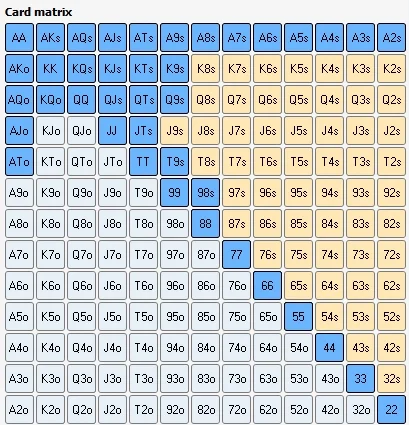What is GTO in Poker
In the ever-evolving world of poker, players have long been looking for a way to consistently outplay their opponents and win every hand. Since poker’s inception, many strategies have been developed, tried and, more often than not, proven to be unsuccessful, either by being sidelined or unraveled by savvy opponents. Amidst this constant search for a winning formula, a sophisticated approach known as Game Theory Optimal (GTO) poker strategy has emerged.
GTO poker represents a paradigm shift in the way the game is approached. It is based on the concept of creating a non-exploitable strategy that, when executed correctly, ensures that a player will not lose in the long run. At its core, GTO is about making mathematically optimal decisions based on a thorough understanding of game theory and poker’s inherent probabilities. This strategy is not aimed at maximizing winnings in every hand, but rather at ensuring that over time a player’s results tend to break even or better, especially against opponents who do not know how to play a perfectly balanced game. The best part of GTO is that it provides a solid foundation from which to measure and adjust any style of play.
Drawing on my own poker journey, I have delved deeply into the nuances of GTO, applying its principles and learning from its complex, often counterintuitive recommendations. My experience has taught me that mastering GTO is not just about memorizing ranges or following patterns, but a fluid, adaptive approach to the game. It requires a deep understanding of both the math behind poker and the psychology of the game that takes place at the table.
In what follows, I will attempt to uncover the intricacies of GTO poker by sharing my insights gained from years of applying, adapting and refining this strategy in poker. Whether you’re a professional looking to hone your approach or a beginner looking to get on par with the poker pros, learning GTO is one of the most important parts of playing poker because virtually all professional players know how this strategy works and often stick to it, making it an essential part of poker strategies.
Basic of Poker Game Theory
Game Theory Optimal (GTO) in poker is a process that is the opposite of exploitative approaches, being one of the most advanced techniques in the game. At its core, GTO is not just a single strategy, but a comprehensive system designed to negate the effectiveness of exploitative play by opponents, thereby ensuring that a player’s actions remain immune to counter-strategies in the long term.
The basic ideology of GTO is to devise a precise strategy of play that will counter your exploitation attempts. This involves careful range balancing – that is, adjusting the distribution of hands with which a player bets, calls or folds to achieve an optimal balance. In this way, it is extremely difficult for a GTO player to identify and take advantage of any predictable patterns or trends in his opponents’ play. This balance ensures that for every action there is an optimal counteraction, creating a scenario in which the GTO player’s strategy is theoretically immune to exploitation.

The main part of GTO lies in its stark contrast to exploitative strategies, which focus on identifying and exploiting opponents’ weaknesses. Whereas an exploitative game adjusts to the specific tendencies of opponents in an attempt to capitalize on their mistakes, GTO takes a more insular approach. It focuses on refining its own strategy to the point where it becomes universally effective, regardless of the actions of its opponents. This is achieved through a deep understanding of poker math, probability, and Nash equilibrium – the point in the game at which each player’s strategy is optimal given the strategies of all other players.
Putting GTO into practice involves combining different poker strategies, carefully calibrated to ensure balance in all possible scenarios. This involves not only a thorough understanding of the standard play for a wide range of hands, but also the ability to adjust these strategies in real time based on the dynamics of each game. The goal is not to maximize the winnings from every hand played, but to optimize the decision-making process in such a way as to achieve consistently positive results over time.
The Basic Idea of Game Theory is Optimal
At the heart of GTO strategy is the principle of distinguishing between favorable and unfavorable hands. This distinction helps players make informed decisions about whether to play a hand aggressively or fold in response to an initial raise, based on a predetermined categorization of strong hands. The strategy carefully determines which hands have the potential for significant winnings and which hands fall into the spectrum of hands best avoided. This delineation is not arbitrary, but is based on a rigorous mathematical analysis that evaluates the expected value of hands within the vast number of possible scenarios presented during the course of the game.
Thus, the GTO approach goes beyond mere guessing, favoring a strategic framework where every action is the result of a calculated decision. The methodology incorporates a comprehensive understanding of poker odds, pot odds, and specific probabilities of improving hands after the flop. By adhering to this analytical rigor, players can make informed decisions that do not depend solely on the unpredictability of their opponents’ actions, but are based on the statistical realities of the game.
Reliance on mathematical rigor and probabilistic analysis allows for a level of play that strives to be unexploitable. Players who master the GTO strategy strive to play a balanced game in which their betting, raising, and folding decisions are optimally tuned to reduce potential losses and maximize the probability of winning. The strategy requires disciplined adherence to its principles, forcing players to resist the temptation to deviate from the calculated path in favor of intuitive or emotional reactions.
What is a Balanced Range in Poker
Professional poker players have moved beyond the simplistic approach of playing strictly from their hands and basing their raises and overall strategy solely on the cards they hold and the cards that appear on the table. A more complex and effective strategy has come to the forefront – the concept of a balanced range. A balanced range in poker means a carefully considered set of hands that a player may have in a given situation, taking into account not only the potential strength of these hands, but also the expected behavior of opponents, as well as the use of bluffing.
A balanced range is essentially an evaluation of the different hands a player may play in a particular scenario, creating a diverse range of possible actions. This approach aims to make a player’s strategy less predictable and more difficult for opponents to exploit. By maintaining a balanced range, the player includes both strong hands and potential bluffs, ensuring that his play remains elusive and difficult to decipher. This strategy is particularly effective because it takes into account the wide range of cards that can appear on the table, allowing for strategic bets and raises that keep opponents guessing.
It is important to note that developing a balanced range begins on preflop, laying the foundation for hand development in subsequent rounds of betting. Beginning with preflop betting, players evaluate their hand in the context of their overall range, considering how it fits into their strategy against their opponents’ possible hands. This initial evaluation drives decisions on whether to bet, raise, call or fold, with the goal of maintaining the integrity of a balanced range throughout the hand.
This preflop evaluation lays the foundation for a subtle game plan that extends to turn and river, where the balanced range continues to guide decisions. By considering the balanced range from the outset, players are able to navigate the complexities of the game with a well thought out strategy. This approach allows for both aggressive play with strong hands and strategic bluffs when the board texture or the actions of opponents indicate an opportunity to capitalize on perceived weaknesses.
How to Make the Right Moves Using the GTO Starter Strategy
As you begin to learn Game Theory Optimal (GTO) poker strategy, it is important to dispel the notion that moves and bets seem chaotic or unreasonable. Contrary to the beliefs of some players, every decision made within GTO is based on mathematical calculations and statistical analysis, far from whimsy or arbitrariness. This precision underscores the essence of GTO, where every move is a calculated move designed to optimize results based on a deep understanding of poker mathematics.

A key component in GTO is the concept of Minimum Defense Frequency (MDF). MDF is a principle that guides players to the minimum percentage of hands in their range with which they should continue to play in order to prevent their opponents from taking advantage of their play. At its core, MDF is about making sure that your defensive actions – whether it’s a call or a raise – are frequent enough to prevent your opponents from favorably bluffing against you.
The basic idea behind MDF is that it defines a threshold for how often you need to defend so that your opponent’s bluffs or aggressive bets are at best break-even. This means that if you defend less often than the MDF suggests, your opponent can take advantage of you by bluffing more often, knowing that you are over-folding. Conversely, by defending more than the MDF suggests, you may lose more chips against their valuable bets.
The formula for calculating MDF is fairly simple, but makes a lot of sense in poker:
MDF= Pot Size / Pot Size+Bet Size
This calculation helps determine the proportion of your range with which you should continue to play after a bet, based on the size of the pot and your opponent’s bet.
In practice, following the MDF can often lead players in tournaments to fold hands that may seem strong or promising against overcalls. Such decisions, while seemingly cautious, are often driven by MDF considerations. The strategy suggests that in certain situations, continuing to draw a hand that seems good may be unreasonable or excessively risky based on the estimated frequency of defense needed to prevent exploitation.
Observing players fold in the face of aggressive betting, even with significant hands, emphasizes the disciplined application of GTO principles. Rather, these players are likely acting in accordance with MDF strategy, which advises them to recognize the danger and potential futility of calling all bets. This is evidence of a delicate balance between aggression and defense based on a deep understanding of the mathematical foundations of poker.
| Bet Size | Minimum Defense Frequency |
| 100% of the pot | 50% |
| 75% of the pot | 57% |
| 66% of the pot | 60% |
| 50% of the pot | 67% |
| 33% of the pot | 75% |
Unpredictability When Playing With a GTO
In poker, where strategy and game psychology are two essential components of the game, the principle of unpredictability is a special part of optimal game theory (GTO). Many players, especially at the beginning and intermediate levels, tend to follow a predictable pattern of play, guided by traditional strategies. This predictability makes their actions transparent, allowing attentive opponents to exploit their tendencies. In contrast, players who adhere to the GTO philosophy often use unpredictability and bluffing as key elements of their strategy, giving themselves a significant advantage over their opponents.
The essence of unpredictability in poker lies in the ability to keep your opponents guessing, weaving together a game so varied and nuanced that it becomes a challenge to identify a pattern. This approach involves not only a balanced combination of hands of different strength spectrum, but also strategic bluffing as a means of disorganization and disorientation of opponents. Developing a personalized unpredictability strategy requires a combination of your own approach, discipline, and understanding of poker dynamics.

A personal strategy for incorporating unpredictability into my GTO approach is to adopt the 3-5 rule. Under this method, I deliberately play the first three games of a session in a passive, conservative style, and in the fourth and fifth games I abruptly shift gears by taking an aggressive stance. This pattern, despite the consistency of my strategy, creates additional difficulties for my opponents as they try to determine my true playing style.
Moreover, I have observed some professional players who take unpredictability to a new level by utilizing time-based changes in their strategy. For example, they may decide to go from tight play to loose play or vice versa, focusing on the position of the hands of the clock. This approach, while unconventional, demonstrates the lengths players go to in order to maintain an aura of mystery around their tactics.
At its core, choosing an unpredictable strategy in poker involves a conscious departure from the norm, a willingness to take risk and complexity in pursuit of competitive advantage. Elements of bluffing, strategic aggression and pattern breaking intertwine to create a unique style of play that is difficult to decipher.
The moment I realized the importance of the GTO and all the factors involved in properly applying this strategy was a turning point in my game. It not only increased my ability to navigate the intricacies of the game, but also made me a formidable opponent whose next move remains a mystery. The desire for unpredictability that is combined with the mathematics of GTO is one of the most complex game strategies in poker, understanding this strategy and applying it to your own practice takes a lot of time and a lot of practice.
Conclusion
Game Theory Optimal (GTO) strategy in poker is a sophisticated tool that, when used with understanding and precision, greatly enhances the play of those who employ it. This strategic approach, with its emphasis on mathematical rigor, balanced play and unpredictability, provides a competitive advantage that can be decisive in high stakes environments. However, it is important to realize that GTO is not a one-size-fits-all solution, especially for newcomers to the poker table.
For beginners, the complexities of effectively implementing a GTO strategy can seem daunting. It requires not only an understanding of poker mechanics, but also a deep understanding of advanced concepts such as range balancing and minimum defense frequency. Therefore, beginners are advised to first familiarize themselves with the basic aspects of poker gameplay, strategy and decision-making before delving into the intricacies of GTO.
On the other hand, for experienced players, mastering the GTO approach can significantly improve the profitability and sustainability of their game. By applying the principles of GTO, experienced players can hone their ability to make non-exploitative decisions, navigate different styles of play, and maximize their chances of success in a variety of poker formats. Skillful application of GTO not only challenges opponents, but also opens up new dimensions of strategic depth, pushing the boundaries of traditional poker wisdom.

